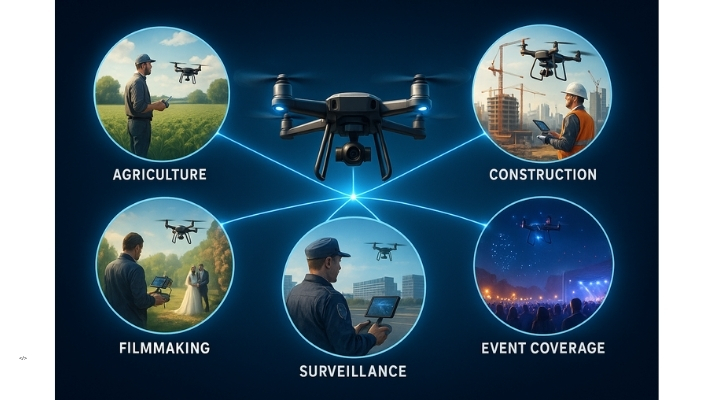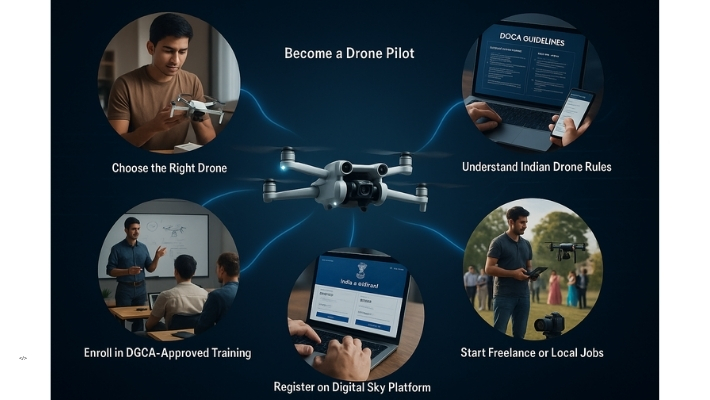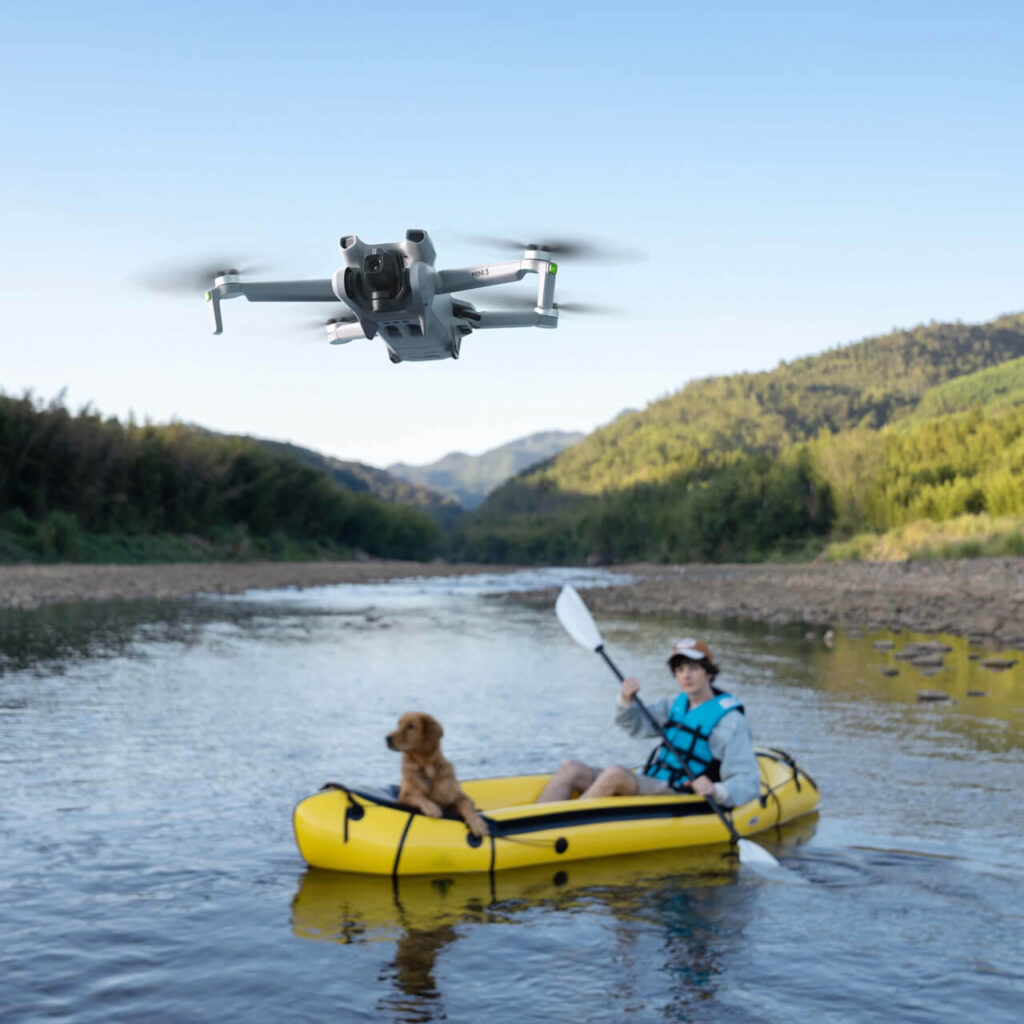The drone industry in India is taking off literally. With sectors like agriculture, real estate, surveillance, mapping, and cinematography increasingly turning to drones for efficiency, the demand for skilled drone pilots is at an all-time high.
But what does that mean for you, as someone considering a career in this field?
Whether you’re a student, a tech enthusiast, or a professional looking for a career shift, drone piloting is no longer a niche hobby it’s a legitimate, growing profession. In 2025, salaries for drone pilots in India vary widely based on experience, certification, location, and the type of work you do.
In this blog, we’ll break down:
- How much drone pilots earn in India
- Which industries pay the most
- What kind of jobs are available
- How to get started with the right certifications
- And whether freelancing or full-time work is more profitable
If you’ve ever asked yourself, “Can I actually make a living flying drones?”you’re in the right place.
Drone Pilot Salary in India: Overview for 2025
Drone piloting is no longer just about cool aerial shots or cinematic reels. In 2025, it’s a professional career path that can pay well across industries like agriculture, construction, surveillance, and content creation.
Here’s a quick snapshot of what drone pilots are earning across India today:

A lot depends on the type of work you take on. For example:
- Aerial surveyors using agriculture drones or flying over construction sites often work on contract.
- Creators who vlog or shoot travel reels with drones earn based on project scale or YouTube monetization.
- Police departments and emergency services now employ trained pilots, especially in states like Gujarat where drone programs are scaling fast.
Also, if you’re capturing solo adventure videos or covering massive events, drones aren’t just a nice-to-have they’re the only way to get that shot.
Industries Hiring Drone Pilots in India (and What They Pay)

The demand for drone pilots in India isn’t limited to one niche. From capturing weddings to inspecting crops and construction sites, skilled pilots are finding work in surprising places. And the salaries? They vary based on how technical or creative the job is.
Here’s a breakdown of major industries hiring drone pilots in 2025 and what they typically pay:
1. Agriculture
- Role: Crop monitoring, pesticide spraying, NDVI analysis
- Monthly Pay: ₹30,000 to ₹70,000
- Trend: With labor shortages in rural areas, agriculture drones are becoming essential tools for modern farms. From Karnataka to Punjab, demand for certified drone operators is growing fast.
2. Construction and Infrastructure
- Role: Surveying, site inspection, 3D mapping
- Monthly Pay: ₹40,000 to ₹90,000
- Trend: Large developers and infra companies now prefer drone-based progress tracking. Some have even shifted trust from manual teams to aerial mapping with drones for better accuracy.
3. Filmmaking & Content Creation
- Role: Cinematic videography, social media shoots, vlogging
- Monthly Pay (Freelance): ₹5,000 to ₹25,000 per shoot
- Trend: Whether you’re a YouTuber, wedding filmmaker, or travel vlogger, drone footage adds instant appeal. For many, buying a drone was the first step to starting their creator journey.
4. Surveillance & Security
- Role: Monitoring borders, cities, or private properties
- Monthly Pay: ₹30,000 to ₹80,000
- Trend: Government departments and private security firms are actively hiring drone operators. From police programs in Gujarat to urban crime-fighting, drones are now part of India’s high-tech watchlist.
5. Event Coverage
- Role: Shooting large public gatherings, drone light shows, rallies
- Pay (Per Event): ₹10,000 to ₹50,000
- Trend: Big brands and state governments now use drones for promotional events, crowd monitoring, and even Guinness Record attempts. It’s a booming space for certified pilots with creative flair.
What Influences a Drone Pilot’s Salary?
Not all drone pilots earn the same, even if they fly similar routes or drones. Your income depends on a mix of factors from the equipment you use to how professionally you position yourself in the market.
Here’s what truly affects your earning potential:
1. Type of Drone You Operate
Advanced drones like the DJI Air series, Autel EVO, or survey-specific models from IdeaForge often lead to higher-paying jobs. These drones are more capable, especially when used for high-precision agriculture, mapping, or infrastructure inspection.
Pilots flying basic camera drones or consumer-friendly models like the Mini 3 or Mini 4 Pro may start with lower rates but can scale quickly with content-focused gigs.
2. Certification & Licensing
Clients and companies now prefer certified pilots with valid DGCA-approved training. Flying without proper authorization is risky — and illegal. In fact, many first-time flyers only realize the importance of licensing after buying their drone.
Some buyers also find out the rules after asking questions like, “Can I fly freely, or do I need a license?”
3. Experience Level
Experience brings trust. A beginner may earn ₹15,000 to ₹25,000 per month, while someone who has flown across diverse landscapes from the Himalayas to coastal shoot locations can charge well into six figures.
Seasoned pilots are also less likely to crash or damage gear, especially when they’ve used drones with built-in safety features like DJI’s obstacle avoidance systems.
4. Region & Market Demand
Pilots in metro cities like Delhi, Mumbai, or Bangalore earn more due to corporate and media demand. That said, small towns and rural zones are catching up fast, especially with the rise of drone-based solutions in agriculture and disaster relief.
Some areas have also seen pilots contracted for blood delivery, emergency relief in flood zones, or police surveillance in high-crime regions.
5. Services You Offer
Are you offering just raw footage, or full post-production? Are you mapping farmland, or doing 3D construction site modeling? The more specialized your service, the better you earn.
Some pilots even offer refurbished drone rentals, drone resale, or field-side training for clients adding new revenue streams to their work.
These factors not only influence your income but also the kind of drone you might need. For example, buying a drone like the Mini 4 Pro makes it easier for content creators to start small but scale fast without complex setups or licensing headaches.
Freelance vs Full-Time Drone Pilot Jobs: What Pays Better?
If you’re thinking about becoming a drone pilot in India, one of the first questions you’ll face is whether to go freelance or look for a full-time job. Both paths have potential but they offer very different lifestyles, income structures, and growth opportunities.
Here’s a closer look:
Freelance Drone Piloting
Many drone pilots start as freelancers, especially if they already own a drone like the DJI Mini series or similar compact models.
Pros
- Flexible schedule take on weddings, travel shoots, real estate projects
- Can charge per project or per day
- No cap on how much you earn it depends on your hustle
- Perfect for vloggers, content creators, or tech-savvy photographers
Cons
- Inconsistent income, especially in off-seasons
- You’ll need to manage your own gear, repairs, and drone registration
- Clients often ask about drone condition making non-refurbished certification a trust factor
Typical Earnings
- ₹5,000 to ₹25,000 per project
- ₹50,000 to ₹1.2L+ per month (depending on bookings and drone quality)
Many creators who document their solo adventures or travel vlogs eventually turn freelance drone work into a full-time business. Some even go from flying recreationally to building portfolios that attract high-ticket clients.
Full-Time Drone Jobs
With the drone industry scaling fast, companies in agriculture, construction, media, and even public safety are now hiring full-time drone operators.
Pros
- Steady monthly income and job security
- Access to enterprise-grade drones without personal investment
- Health insurance, PF, and other benefits (in larger firms)
- Opportunities to work on large-scale projects from infrastructure mapping to state-sponsored drone programs
Cons
- Less flexibility in work schedule
- Fixed salary, even when project intensity is high
- You may need to travel frequently or relocate for site work
Typical Salary
- ₹25,000 to ₹80,000/month
- Can go up to ₹1.5L with experience and certifications
So, Which Pays Better?
- Freelancing can pay more, especially if you’re well-networked, have strong editing skills, and use high-end drones.
- Full-time jobs offer security and consistency, which appeals to new entrants or those shifting careers.
Some drone pilots choose a hybrid path freelancing on weekends while holding a weekday job. Others evolve into educators, drone sellers, or even start drone-based service businesses using their older gear, or by reselling used drones online.
How to Become a Drone Pilot in India (Step-by-Step)

With drone applications expanding across agriculture, construction, events, and filmmaking, the path to becoming a licensed drone pilot in India is more structured than ever. Here’s how to get started the right way.
Step 1: Choose the Right Drone
If you’re just starting out, don’t rush into buying an expensive model. Start with something reliable and easy to handle like the DJI Mini 4 Pro or even the Mini 3. These drones are perfect for beginners and don’t require complex setup or permits in most cases due to their light weight.
Some people jump into drone flying for content creation or gifting, only to realize they’ve bought a refurbished unit without knowing how to check. Always verify before flying.
Step 2: Understand Drone Rules in India
Before you fly, you need to understand Indian drone laws.
Key points include:
- Drones are classified based on weight: Nano (<250g), Micro (250g–2kg), Small, Medium, Large
- Nano drones usually don’t require permission, but flying above 50 feet or near airports is restricted
- Heavier drones need DGCA registration and a pilot license
If you’ve wondered whether you can fly without a license or take a drone abroad, now’s the time to read up on flight rules and import restrictions
Step 3: Enroll in a DGCA-Approved Drone Training Program
To become a certified drone pilot in India, you must complete a training course from a DGCA-authorized Remote Pilot Training Organization (RPTO).
Training typically covers:
- Drone hardware and software basics
- Weather reading and airspace rules
- Simulated flying hours
- Real-world flight assessments
After passing, you’ll receive a Remote Pilot Certificate, which qualifies you to fly small and medium drones commercially.
Step 4: Get Your Drone Registered on the Digital Sky Platform
Every commercial drone and pilot must be registered on India’s Digital Sky Platform, managed by DGCA. You’ll need to submit:
- Your Remote Pilot Certificate
- Drone type and serial number
- Insurance documents (if required)
Once approved, you’ll get a Unique Identification Number (UIN) for your drone and a Remote Pilot License (RPL) under your name.
Step 5: Start with Local Jobs or Freelance Projects
Begin with smaller gigs school events, real estate shoots, or local tourism boards. You can also sign up on freelance platforms or partner with drone service providers who offer rental models or pre-owned drones for newer pilots.
Over time, you might consider upgrading to heavier models, especially if you enter commercial survey work or specialized industries like forest surveillance, disaster response, or agriculture spraying.
Best Drones to Start Your Pilot Career in 2025
Choosing the right drone can set the tone for your entire career. Whether you’re planning to shoot cinematic content, map farm fields, or monitor construction sites, your first drone should be easy to fly, reliable, and legally compliant for Indian airspace.
Here are 5 solid picks to get started with in 2025:
1. DJI Mini 4 Pro
- Weight: Under 250g
- Camera: 4K HDR, obstacle avoidance
- Why it’s ideal: It’s beginner-friendly, doesn’t require a license under DGCA rules, and comes loaded with safety features perfect if you’re worried about crashing your first drone.
2. DJI Mini 3
- Weight: 248g
- Camera: 4K with True Vertical Shooting
- Why it’s ideal: More affordable than the Mini 4 Pro, but still powerful for vlogging, real estate work, or solo adventure content. Works well for those who just want to test the waters before scaling up.
3. Autel EVO Nano+
- Weight: 249g
- Camera: 50MP with RYYB sensor
- Why it’s ideal: A strong alternative to DJI, especially if you’re into content creation. The camera is excellent for low-light scenes, and the build quality is robust.
4. Parrot Anafi
- Weight: ~320g
- Camera: 4K HDR with 180° tilt
- Why it’s ideal: Great for aerial filmmakers. Its upward-tilting gimbal gives you shots that most other drones can’t. Well-suited for creators and freelancers working on cinematic or corporate projects.
5. IdeaForge Q Series (Entry-Level Model)
- Weight: Varies (some micro/light commercial)
- Camera: Mapping-grade, stable in wind
- Why it’s ideal: Ideal for those entering the agriculture or survey sectors. It’s more of a career investment, best suited for those planning to pursue certified drone operations.
Each of these drones fits a different starting point whether you’re buying for personal growth, gifting, or building a freelance portfolio. Many pilots start with a Mini and then upgrade once their bookings or contracts grow.
FAQs About Drone Pilot Careers and Salary in India
These are some of the most common questions aspiring drone pilots ask when they’re just starting out.
1. Do I need a license to become a drone pilot in India?
Yes — if you’re flying a drone heavier than 250g for commercial use, you must have a DGCA-approved Remote Pilot Certificate. Lighter drones like the DJI Mini 4 Pro don’t require a license if flown below certain altitudes and in open areas.
2. What’s the starting salary for a drone pilot in India?
Beginners typically earn ₹15,000 to ₹35,000 per month. With more experience, the salary can rise to ₹1.5 lakh or more, especially in industries like construction, agriculture, and aerial cinematography.
3. Can drone piloting be a full-time career in 2025?
Absolutely. Many professionals work full-time with real estate firms, agri-tech companies, or media houses. Others choose to freelance or start their own drone service businesses. There’s even growing demand for event coverage, forest monitoring, and rescue operations.
4. Is freelancing more profitable than full-time jobs?
It can be — especially if you build a strong network and offer high-value services like aerial mapping or content production. Freelancers often earn more per project, though income can vary month to month.
5. Which drone is best for getting started in India?
If you’re a beginner, the DJI Mini 3 or Mini 4 Pro is a great place to start. They’re lightweight, easy to fly, and packed with safety features. Plus, they’re perfect if you’re exploring vlogging, gift ideas for creators, or just want to fly without worrying about complex registration.



